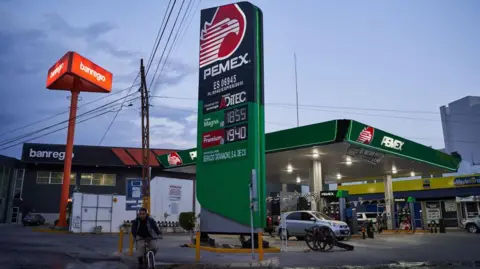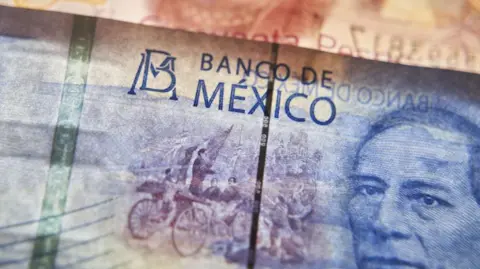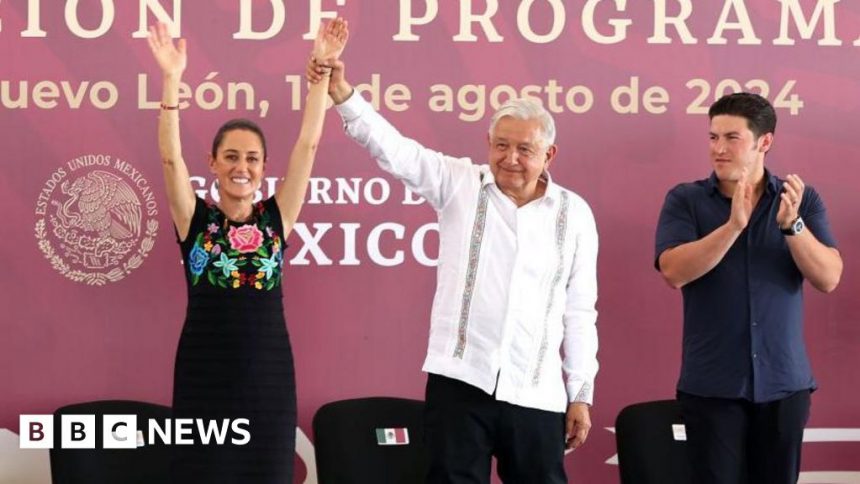Mexican economy a mixed bag for new president
 Getty Images
Getty ImagesAfter handing the reins of power to Claudia Sheinbaum on 1 October, Mexico’s outgoing president, Andrés Manuel López Obrador, hoisted her arm aloft in a joint show of victory.
López Obrador – a hugely popular but controversial figure in Mexico – bequeathed more than just the presidential sash to his political protégé.
She inherits a nation, and an economy, that is performing well in some areas, and facing significant challenges in others.
The good news from her government’s perspective is that Mexico has strengthened its trade position with its neighbour to the north, displacing China as the US’s biggest trading partner.
Mexico has benefitted from “nearshoring” – that is, the relocation of US and Asian firms from China to northern Mexico to bypass punitive US tariffs on Chinese exports.
“Mexico has always been attractive to capital flows because of our geographical position, our free trade agreements with North America, our work force,” former Mexican trade negotiator Juan Carlos Baker Pineda told me before the election.
“But over the past few years, it increasingly seems that if you [a foreign firm] want to do business with the US you need some kind of footing in Mexico.”
The outlook is optimistic, he believes, pointing to Amazon’s recent announcement that it will invest $5bn (£3.8bn) in Mexico over the next 15 years, and an additional $1bn investment by German carmaker Volkswagen. Mr Baker Pineda also cites promising plans from South African, Japanese and Chinese firms.
Critics are less convinced that the relocation of manufacturing from Asia to northern Mexico benefits the Mexican economy rather than just bolstering the companies involved. The key, Mr Baker Pineda believes, lies in creating the right “corporate and government decisions in this country to sustain this trend in the long-term”.
When it comes to the immediate economic problems President Sheinbaum faces, the most pressing is state-run energy firm Pemex. It has debts of around $100bn, making it the world’s most indebted oil firm.
“The debt is a problem not just for Pemex but for Mexico,” says Fernanda Ballesteros, Mexico country manager for the Natural Resource Governance Institute.
In recent years, the López Obrador administration has reduced the amount of tax Pemex has had to pay the government. This has been cut by 60% to 30%.
At the same time, the outgoing government gave Pemex a number of cash injections, which López Obrador says he would like to see continue.
However, a steady decline in productivity at Pemex in recent years has further complicated the financing of the state-owned energy giant, which employs around 1.3 million people according to the government’s own statistics.
 Getty Images
Getty Images“President López Obrador’s policies and priorities were to double down on fossil fuels and give unconditional support to Pemex,” says Ms Ballesteros. The company is now poorly positioned, she argues, for the necessary transition to cleaner and more efficient energies in the coming decades.
“Over the past six years, 90% of Pemex’s infrastructure investments have gone towards a new refinery in Dos Bocas in Tabasco state, and the acquisition of a refinery in Deer Park in Texas.”
The government says it is on course to achieve its goal of total self-sufficiency in fuels by the first quarter of 2025. However, Pemex’s ongoing economic difficulties mean the Sheinbaum administration has its hands tied over servicing the colossal debt.
Environmental expert Eugenio Fernández Vázquez says that Pemex is a “big challenge” for Sheinbaum. “Not just in dealing with the oil industry, which is huge in terms of Mexico’s GDP, but also in taking Pemex’s massive debt burden off the public’s shoulders,” he explains.
Sheinbaum must strike a difficult balance, he adds, in getting Pemex to sell more of its products “which are obviously fossil fuels and oil-based, while at the same time addressing Mexico’s climate change responsibilities and dealing with urgent issues in our cities, like air pollution”.
For a president championed as Mexico’s most environmentally conscious leader – before entering politics, Sheinbaum was an accomplished environmental engineer – that must rankle. Especially while also spending billions in public money to prop up a greenhouse gas-emitting behemoth.
Back in the realm of Mexico’s complex relationship with its northern neighbour, President Sheinbaum faces two very different prospective partners in Washington – either the first female president of the US in Kamala Harris or a second Trump presidency.
Whoever wins in November, there are some tricky cross-border issues to address, whether on trade or undocumented immigration, the illegal traffic of guns into Mexico, or fentanyl into the US.
Furthermore, the United States-Mexico-Canada Agreement (USMCA) free trade deal is up for renegotiation in 2026, with everything from minor tweaks to major rewrites possible.
USMCA was introduced in 2020, when it replaced the previous North American Free Trade Agreement between the three countries.
Sheinbaum also has to keep an eye on the peso. In the days after her election victory in June, the currency tumbled against the dollar.
This was largely in response to a decision by the outgoing president to press ahead with a wholesale reform of the country’s judicial system under which all 7,000 judges and magistrates in Mexico will be chosen by popular vote. The plan is also supported by Sheinbaum.
Washington’s disapproval of the measure, as publicly expressed by the US Ambassador to Mexico, Ken Salazar, suggested it could complicate, even jeopardise, parts of the USMCA renegotiation. Relations between Ambassador Salazar and the new administration are already notably frostier.
 Getty Images
Getty ImagesDiplomatic spats aside, marrying the new constitutional rules with the legal requirements of the free trade agreement could prove far thornier than first anticipated.
Still, these are the very first days of President Sheinbaum’s administration. As part of her predecessor’s legacy, she enjoys an almost unprecedented level of support with the ruling party in an unassailable position across the country.
Her key election promise – to extend López Obrador’s social programmes in pensions, family stipends and student grants, and build what she calls the “second floor” of his political project – secured her the backing of millions of Mexicans.
She can also count on a loyal congress and, following the reform, potentially the control of the judiciary, too.
Taking office in such a powerful position is a luxury, one which supporters and critics alike expect her to use to properly address some of Mexico’s main economic obstacles.








